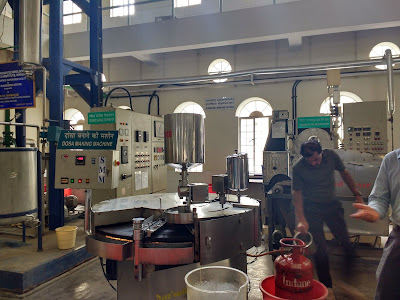Recently I got an opportunity to visit the Central Food Technological Research Institute (CFTRI) in Mysore. I was part of a group that was taken around the institute by some of its expert officers. It was a very interesting and enlightening tour. The institute is housed in a grand mansion. It was built by Maharaja Krishnaraja Wodeyar IV for the third princess of Mysore. As we approached the building, we were impressed with the sight of the imposing facade. The interiors are equally stately and well-maintained.
The institute is one of the 42 national research laboratories set up by the government under the Council of Scientific and Industrial Research (CSIR). It develops technology and equipment that the food industry can use in making their products better in many ways.
Gone are the days when we used to buy pulses and grains from the neighbourhood grocer who would pack them in newspaper sheets before handing them to us. Today an array of processed, semi-processed and unprocessed food vies for our attention from attractively arranged shelves in supermarkets. Then there is the booming online market too. Advances in agriculture have meant better and more yield of crops and fresh produce. This has resulted in requirement of superior technology to preserve and package food in such a way that it can be transported to different parts of the country and the world, retaining as many nutrients as possible while ensuring its longer life at the same time. If this is not done, a lot of food will be wasted for want of proper preservation and distribution. So, some foods need to be packed in a certain way using certain types of materials, some foods need to be dehydrated, while some need to be frozen or roasted or pickled to save them from getting wasted.
The experts at the institute explained to us what all the institute does to achieve its goals. They made it interesting and interactive so as to engage laypersons like us in the proceedings. We walked through a section of the institute where the walls are covered with informative posters filled with charts, pictures and numbers decribing various techniques in a simple way. It is done quite well and all of us appreciated it. Then looking at and looking through the scanning electron microscope was a unique experience. It produces greatly magnified images of objects in very high resolution. It was interesting to see images of the surface of a chapati and that of a puri through it.
They demonstrated the use of a dosa making machine and offered the tasty samples to us. They were really very good! This machine and a chapati making machine have been developed at the institute. They are suitable for use in temples, gurudwaras, canteens and hospitals where a large amount of food needs to be made efficiently and hygienically.
We saw many other things and learnt a whole lot which is not possible to reproduce here. I am grateful to all those who made this visit possible. It has made me realise how much thought goes into designing the size, shape, texture, packaging and storage of a food item that we casually pick up from a supermarket. If it has made life easy for us, we should be thankful to the farmers, scientists and food technologists who have worked towards it.
The institute is one of the 42 national research laboratories set up by the government under the Council of Scientific and Industrial Research (CSIR). It develops technology and equipment that the food industry can use in making their products better in many ways.
| Photo by CSRI |
 |
| Photo by Lata |
They demonstrated the use of a dosa making machine and offered the tasty samples to us. They were really very good! This machine and a chapati making machine have been developed at the institute. They are suitable for use in temples, gurudwaras, canteens and hospitals where a large amount of food needs to be made efficiently and hygienically.
We saw many other things and learnt a whole lot which is not possible to reproduce here. I am grateful to all those who made this visit possible. It has made me realise how much thought goes into designing the size, shape, texture, packaging and storage of a food item that we casually pick up from a supermarket. If it has made life easy for us, we should be thankful to the farmers, scientists and food technologists who have worked towards it.